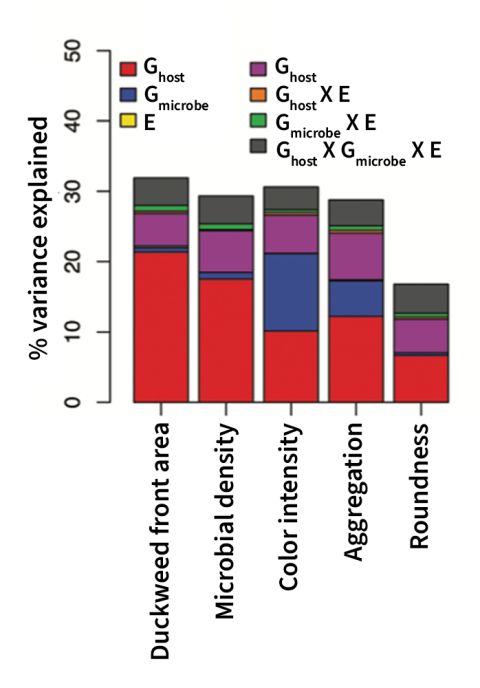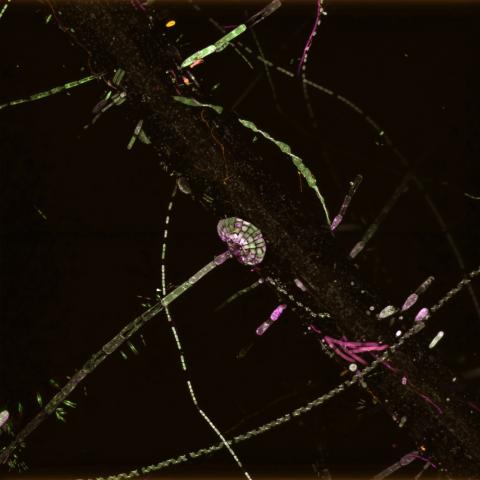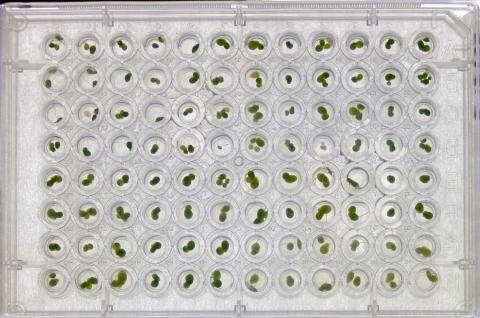This research was published in the INSPIRED: A Publication of the New Hampshire Agricultural Experiment Station (Spring 2024)
Researchers: A. O’Brien, J. Laurich and M. Frederickson
A plant’s traits can vary due to its genetics and due to experiences during that organism’s life, which can result in different traits. Experiences that can change the influence of genetics on traits include changing interactions with other organisms or environmental context. Urban environments are very different from rural environments, and could be one such context that shifts plant traits. For aquatic plants, urbanization could be particularly influential due to a higher density of pollutants in waterways, and how specific contaminants impact plant evolution and traits is an area of research need.
Duckweed as a Model Aquatic Plant
Aquatic environments are especially impacted within urban landscapes, where there are water bodies contaminated with pollutants from human-built surfaces. A particular contaminant is the heavy-metal zinc, originating from roofs, tires, and metal structures. To begin understanding aquatic plants’ plasticity—experiences during an organism’s life that can result in the development of different traits—and genetic trait variations, the research assessed populations of a model aquatic plant duckweed (Lemna minor) across an urban-to-rural gradient. Specifically, the goal was to quantify the extent to which duckweed traits depended on three components: the presence of zinc, the variation found in microbial communities collected across the urban-to-rural gradient, and the variation across the duckweed genotypes themselves.
Microcosms to Understand Sources of Trait Variation
The study created small, experimental microcosms that are meant to mimic characteristics of larger environments. The microcosms contained duckweeds collected from across different urban, rural, or intermediate environments, along with microbes collected from duckweeds at the same sites. Each microcosm was grown either without zinc or with the contaminant at levels found in highway runoff and in nature.

Fig. 1. Percent of variation explained by treatments for duckweed fitness (frond area), and each trait, including total microbial density (optical density at 600 nm, a measure of summed microbial growth across community members).
The researchers factorially combined all possible combinations of the 10 sources of duckweeds and microbes (100 combinations in total) in both contaminated and uncontaminated microcosms, with each well in a well plate representing a unique microcosm (Fig. 1). After letting the microcosms grow, plant growth and traits of each microcosm were assessed, including total microbial cell density.
Results and Impacts
Scientists have long known that variation in plant genomes contributes substantially to variation in plant traits. However, aspects of plant abiotic factors such as pollution or biotic factors like microbiomes can also contribute to plant traits.
For duckweed, the study found that differences in microbes from across the sites where duckweed grew contributed nearly as much to variation in plant traits as did variation in plant genomes—especially when considering the genotype-dependent effects of microbiomes. Specifically, plant genomes contributed up to 21% across traits, microbiomes up to 11% alone, but up to 16% including plant-genotype dependent effects. In contrast, pollution and the effects of pollution that depended on microbiomes contributed very little to differences in plant traits.
Genotypes of plants sourced from urban environments grew faster, which matches similar observations of other organisms from urban environments. Otherwise, the traits of the duckweed genotypes from urban and rural environments did not consistently differ.
Communities of microbes from urban and rural environments did not have consistently different effects on duckweed traits. However, this depended on the presence of zinc, which disrupted interactions between duckweeds and their microbiomes when at a level commonly found in urban environments. In the presence of a zinc contaminant, combining microbiomes and duckweeds collected from the same site resulted in reduced plant and microbial growth. Interestingly, other researchers have also found that urban environments can disrupt interactions between plants and their microbes.
The researchers also found that microbiome composition predicted effects on plant traits, regardless of the zinc treatment. Microbiomes that were very similar in composition had very similar effects on duckweed traits (Fig. 2).

Fig. 2. Similarity of trait values of duckweeds (y-axis) is higher when the dissimilarity of the microbiomes across which they are compared is lower (x-axis). Note: Plots from left to right represent different fitness and trait measures: duckweed frond area (duckweed fitness), microbial density (optical density at 600 nm, a measure of total microbial growth), duckweed frond color intensity, duckweed area:perimeter ratio (aggregation), and duckweed frond roundness. Lines and shaded regions represent predicted mean and 95% highest posterior density intervals (HDPIs) for significant relationships. Each point’s pairwise trait similarity (y-axis value) is a correlation between duckweed genotype means across one pair of inoculated microbiomes.
Implications for the Future
The research found that the urban contaminant zinc did not directly impact aquatic plant traits. However, there were many indirect effects of zinc on duckweed growth and traits via microbiome-dependent effects, shifts in evolutionary pressures, and shifts in trait heritability. Future research should consider how indirect ecological, evolutionary, or combined effects of contaminants entering waterways might impact aquatic life. Moreover, municipal, state, and regional communities should be aware of the complex manner in which water contaminants can impact local aquatic plant life.
Funding and support for this research was provided by the Gordon and Betty Moore Foundation and a National Sciences and Engineering Research Council of Canada (NSERC) Discovery Grant.
Key Findings
- Levels of heavy metal contaminants in water differ across urban and rural environments, and these differences can have complex impacts on the ecology and evolution of aquatic plant organisms.
- Duckweed, a model aquatic plant, would be minimally affected by the common pollutant zinc – if it weren’t for the effects of zinc that act through the microbiome.
- Zinc exposure at levels commonly found in urban environments disrupted interactions between duckweeds and their local microbiomes, significantly worsening plant and microbial growth.
About the Co-author

Anna O'Brien, Assistant Professor of Molecular, Cellular, and Biomedical Sciences
Contact information: Anna.OBrien@unh.edu, FindScholars profile

Microscopic image of duckweed (Lemna minor). Image courtesy of Anne O’Brien, Nicholas Deakin, Ph.D., Nikkon Instruments.

An image of duckweed shown in a 96-well plate. Image courtesy of Anne O’Brien.

